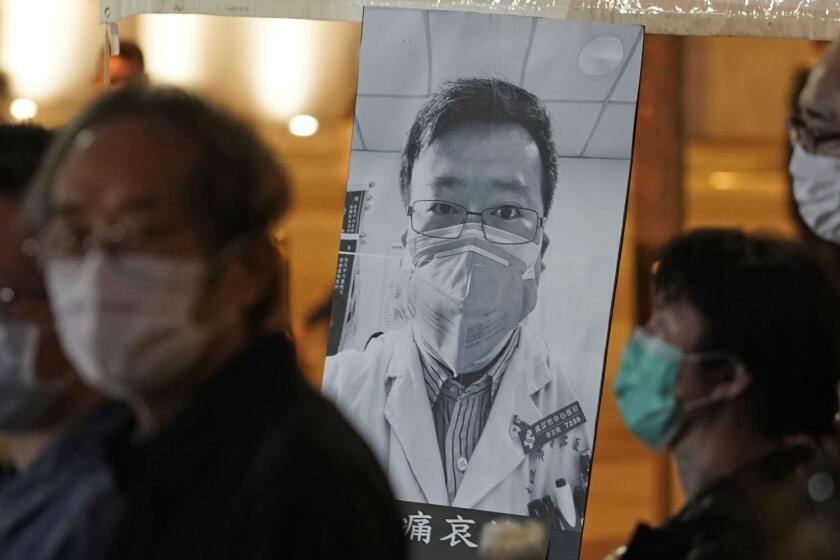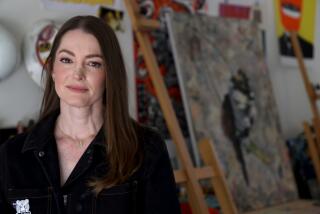Hollywood has gone home. Why are many visual effects artists still going into work?
- Share via
Alongside a 12-member team, in a room no bigger than 500 square feet, a Los Angeles-based visual effects artist worked elbow-to-jowl in secrecy. Nobody else was allowed in the room, and those inside could not discuss the film project with anyone outside. “We were on lockdown,” he said.
It was barely two weeks ago, when reports of the highly infectious novel coronavirus began to dominate headlines, when Italy went under quarantine, Tom Hanks revealed he had contracted COVID-19 and the NBA announced it was suspending its season.
But the artist, whose work as a digital compositor involves such postproduction sleights of hand as digitally extracting actors out of green-screen shots or adding blood squiggles to zombies, was required to work on-site with his cohorts.
“I was nervous,” said the digital compositor, who declined to be named out of fear of losing his job. “People were coughing. It was very nerve-racking for me. Luckily, we were all fine.”
At a time when Hollywood has shut down production to slow the spread of the virus, and most Americans have headed to the safety of their homes, an army of digital effects workers has remained in their studio cubicles, plugging away on computers in close quarters.
Like it or not, many have been required to work on-site, largely because of stringent nondisclosure agreements they must sign.
The agreements were intended to protect intellectual property and prevent leaks and copyright theft. However, they have also made working remotely difficult, as workers generally aren’t allowed to take materials off-site because of security compliances.
The latest updates from our reporters in California and around the world
The system has ignited a storm of criticism.
“The concept that workers must come into work and possibly put their health and life in jeopardy is outrageous,” said Scott Ross, who ran Industrial Light & Magic in the 1980s and was a founder of Digital Domain. “Over the past 10 to 15 years there have been a lot of distance collaborations between facilities working on projects; why not among teams working in the same company?”
Mario Rokicki, a color supervisor at Double Negative in Vancouver, Canada, was thinking the same thing and decided to put the question to the people holding the levers of power: the movie studios. On Saturday he launched a petition on change.org in the form of an open letter to the Motion Picture Assn., imploring the industry to “allow VFX artists to work remotely.”
“Many high-technology companies sent their staff home and provide remote working capabilities,” the petition states. “Unfortunately, VFX Studios around the globe that work on projects for the Hollywood Studios and Streaming Companies are prevented from providing remote working solutions to their staff.
“NDAs [nondisclosure agreements] pushed on VFX studios don’t allow artists, production, tech and support staff to work from home. With often overcrowded facilities and artists that sit elbow-to-elbow pushing long hour days with overtime puts not only me but also my loved ones at risk of catching the virus.”
As of Friday, more than 7,600 individuals had signed the petition, representing a broad swath of VFX workers in Los Angeles, Vancouver and other cities. They’ve worked on such productions as “Avatar,” “The Avengers” and “Star Wars,” and for a number of effects shops, including Cinesite, the Foundry and Double Negative.
Rokicki, who stressed that he was acting as an individual and not as a representative of Double Negative, explained, “I wanted to help the special effects facilities by pressuring the movie studios to help with the NDAs. We have all this advanced technology to work on special effects, but we’re locked down in studios.”
A representative of the MPA, which represents all the studios, did not respond to requests for comment.
In a statement, a representative for Double Negative said the company is working to make its offices around the world fully remote, with some already partly enabled.
“Our priority is always to provide a safe and sustainable workplace for our artists and employees across the world, and we are responding by deploying remote working for all those who can work from home, and following local government advice to ensure that we are always responsive to fast-changing priorities,” the representative said, adding that the Los Angeles team is working fully remotely.
Fiercely protective of their IP, the studios by and large require the special effects shops they contract with and the workers they hire to sign rigid NDAs.
One studio executive who was not authorized to comment publicly noted that these contracts were drawn up without anticipating a crisis that would force widespread social distancing.
Concerns over leaks and hacking spiked in the wake of the cyberattack that hit Sony Pictures Entertainment in 2014. A hacker group calling itself Guardians of Peace stole troves of sensitive data, demanding that Sony cancel its scheduled release of “The Interview,” a comedy about two Americans who try to assassinate North Korean leader Kim Jong Un.
Over several weeks, the group then leaked onto the internet masses of information, including some embarrassing emails between executives and thousands of Social Security numbers belonging to people connected to the company. In addition, multiple new and unreleased movies were leaked online in the wake of the hack.
“It’s the clients [the studios] that insist on these draconian NDAs,” said the Los Angeles VFX artist who described being on lockdown with his team. “The VFX studios have to comply, or the client will say they will hire someone else that will follow their security procedures.”
The Times spoke with 10 visual effects workers, and nearly all feared retaliation for speaking out. Given the current unfolding health crisis, they question the continued insistence on being asked to work on-site in order to comply with security concerns.
The situation is not static or uniform, however. Some smaller shops, and even some of the majors, began making allowances for remote deployment as soon as state and federal governments implemented guidelines for social distancing and, in some cases, sheltering in place. Gov. Gavin Newsom on Thursday ordered all Californians to stay at home.
However, VFX workers say these initiatives need to go further. They complain that many of their cohorts have been given the option to use sick leave or vacation time if they want to stay home. Others fear they are going to be let go with no date of return.
The artists who create movie and TV visual effects have long complained of long hours and difficult working conditions without health insurance or pensions, sometimes describing their situation as “electronic sweatshops.” Several years ago, efforts to unionize and improve working conditions failed.
The rampant outsourcing of jobs in recent years — enticed by generous tax incentives in places like Vancouver as well as Mumbai, India — also has roiled the sector and created the necessity to establish a physical office.
“Film subsidies don’t care where you are,” said industry veteran Scott Squires. “There are no special resources. You’re still in a cubicle; you’re just in a different town or country, but to qualify you have to have people in that specific area.”
As a result, when this health crisis hit, much of the VFX sector was caught flatfooted, without the kind of infrastructure that would enable large numbers to work remotely.
Various studios now are scrambling to respond to this new reality both technologically and legally.
In the last three weeks, Industrial Light & Magic, the digital effects studio based in San Francisco and owned by Walt Disney Co., moved to set up its artists to work from home, according to someone familiar with the company who was not authorized to comment. The studio has completed remote deployment in San Francisco and Vancouver and is working to set up its three other global studios in an effort to follow safety and security guidelines and to alleviate concerns about working on-site.
Another big player, Sony Pictures Imageworks, has been trying to transition employees to remote work over the last few days. Imageworks, which has roughly 800 employees, primarily in Vancouver and Los Angeles, was able to move at least 400 people to work-from-home status by Friday.
For those who remain in the office, the company has implemented safety measures to keep people from working close together. Work spaces that were crowded a week ago are much more open now, allowing people to keep their distance from one another, the spokesman said.
Another major studio that works with multiple effects shops has announced systems requirements for vendors as those companies prepared to transition to working largely from out of the office, said an executive who was not authorized to comment publicly.
This person said the challenges for vendors had more to do with the scale of the situation than any contractual obligations to the studios.
Many believe the coronavirus will force the industry to make similar changes, to keep workers not only safe but employed.
Daniel Lay, who blogs under the name VFX Soldier, says if studios and VFX shops could relax some of the NDA requirements or make exceptions so that clients wouldn’t seek financial or legal ramifications, that would go a long way.
He points to the medical profession, which has made significant adjustments by allowing doctors to see and advise patients online and by telephone, without violating HIPAA standards.
“If the MPA and studios could do the same, it would help, so workers could work from home and a lot of productions could continue,” Lay said.
John Griffith, the former previsualization director at 20th Century Fox, agrees. Five years ago he relocated from Los Angeles to Memphis, Tenn., and hatched his digital firm, CNCPT, designed specifically with work-from-home capabilities for him and the artists he employs.
“It just made sense logistically,” he said, “and the internet speeds and communication technology are so fast and immediate, it makes it possible.”
Griffith notes that there’s more demand for VFX artists than ever, and a remote option has numerous upsides when it comes to lowering costs and environmental impact.
“That’s why I designed my company as remote from the start,” he said.
“With this virus’ impact, it seems be what everybody is talking about,” Griffith added. “This is a path people should follow. It’s all data at the end of day.”
Times staff writer Ryan Faughnder contributed to this report.
More to Read
Inside the business of entertainment
The Wide Shot brings you news, analysis and insights on everything from streaming wars to production — and what it all means for the future.
You may occasionally receive promotional content from the Los Angeles Times.











